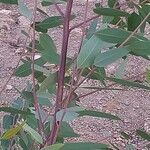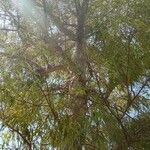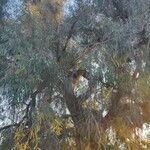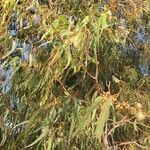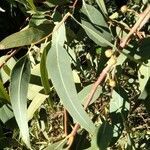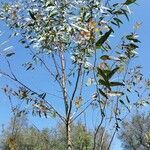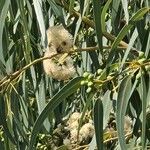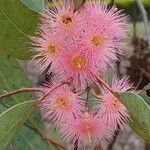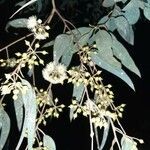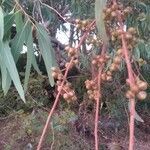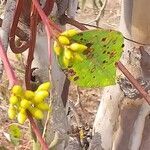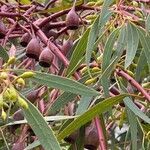Tree commonly to 20 m high, occasionally to 45 m. Bark smooth throughout, white, grey, brown or red. Juvenile leaves ovate to broadly lanceolate, green, grey-green or blue-green, slightly discolorous. Adult leaves lanceolate to narrowly lanceolate, acuminate, moderately thick; lamina 8–30 cm long, 0.7–2 cm wide, green or grey-green; lateral veins at 40°–50°; intramarginal vein up to 2 mm from margin; petiole terete or channelled, 12–15 mm long. Umbels 7–11-flowered; peduncle slender, terete or quadrangular, 6–15 mm long; pedicels slender, 5–12 mm long. Buds globular-rostrate or ovoid-conical; operculum hemispherical, rostrate or conical, obtuse, 4–6 mm long, 3–6 mm wide; hypanthium hemispherical, 2–3 mm long, 3–6 mm wide. Fruits hemispherical or ovoid, 5–8 mm long and wide; disc broad, ascending; valves 3–5. Seeds yellow. [For more recent description see subspecies profiles-Editor]
Tree 20(–45) m tall with smooth bark.. Juvenile leaves ovate to broadly lanceolate; adult lanceolate, 8–30 cm long, 0.7–2 cm wide; petiole terete or channelled, 1.2–1.5 cm long.. Umbels 7–11-flowered; peduncle slender, terete or quadrangular, 0.6–1.5[2.5] cm long; pedicels slender, 0.5–1.2[1.4] cm long.. Buds globular-rostrate or ovoid-conical; operculum hemispherical and rostrate to conical and obtuse, 4–6 mm long, 3–6 mm wide.. Calyx-tube hemispherical, 2–3 mm long, 3–6 mm wide.. Fruits hemispherical or ovoid, [4]5–8 mm long and wide with broad ascending disc and 3–5 exserted valves; seed yellow, smooth.. Fig. 5/7, p. 30 & 11/1–2, p. 51.
Evergreen tree, 18-40 m high, with a spreading crown. Bark shed in various pieces from entire length of trunk, leaving a smooth or granular texture on under layer, white or grey, mottled, streaked with red, sometimes with rough, reddish brown or black bark accumulating at base of trunk. Leaves alternate or opposite; drooping; petioles and twigs red; blade narrowly ovate, 120-220 mm long, apex acute, margins entire, concolorous, distinctly veined. Flowers: in simple umbels; buds conical, ovoid or beaked, 6-9 mm long; stamens exserted; perianth dull yellow; Sep.-Jan. Fruit a capsule with a prominent rim and protruding valves.
Tall tree. Bark on upper part of bole smooth, dull white or ash-coloured, deciduous in long strips, at base of bole rough, blackish, exuding gum, flaking in plates c. 3-5 cm in diam. Leaves up to 25 x 1.5 cm narrowly lanceolate, falcate, apex narrowly acute. Umbels axillary, 5-10-flowered; peduncles 1-1.5 cm long, terete; pedicels 0.5-0.7 cm long, slender, longer than and sharply differentiated from the receptacle tube; flower-buds c. 0.8 x 0.5 cm subglobose and rostrate; operculum markedly rostrate, 1.5-2 times as long as the receptacle. Fruit c. 0.7 x 0.7 cm subglobose; valves usually 4, strongly exserted.
Evergreen tree, 18-40 m high, with a spreading crown, smooth, mottled, white or grey bark, often tinged red in very cold localities. Leaves pale, dull green; adult leaves 120-220 mm long, narrow, pendulous; juvenile leaves smaller and broader; twigs and petioles red. Flowers cream-coloured with long-exserted stamens, buds conical, eggshaped, or beaked, up to 10 mm long. Flowering time Sept.-Jan. (all year). Fruit a brown to reddish brown capsule, 7-8 mm long, with prominent rims and protruding triangular valves.
A graceful tree 10-20 m high. It can be 45 m tall. It spreads 15-35 m wide. The bark is grey and white. The small branches hang down. The leaves are smooth, narrow and sword shaped. They are 10-25 cm long by 1-3.5 cm wide. They are grey-green. They have a long pointed tip. The fruit are small cup shaped woody capsules. They are 0.5 cm across.
Umbels axillary, 5–10-flowered; peduncles 1–1·5 cm. long, terete; pedicels 0·5–0·7 cm. long, slender, longer than and sharply differentiated from the receptacle tube; flower-buds c. 0·8 x 0·5 cm., subglobose and rostrate; operculum markedly rostrate, 1·5–2 times as long as the receptacle.
Bark on upper part of bole smooth, dull white or ash-coloured, deciduous in long strips, at base of bole rough, blackish, exuding gum, flaking in plates c. 3–5 cm. in diam.
Leaves up to 25 x 1·5 cm., narrowly lanceolate, falcate, apex narrowly acute.
Fruit c. 0·7 x 0·7 cm., subglobose; valves usually 4, strongly exserted.
Tall tree.
